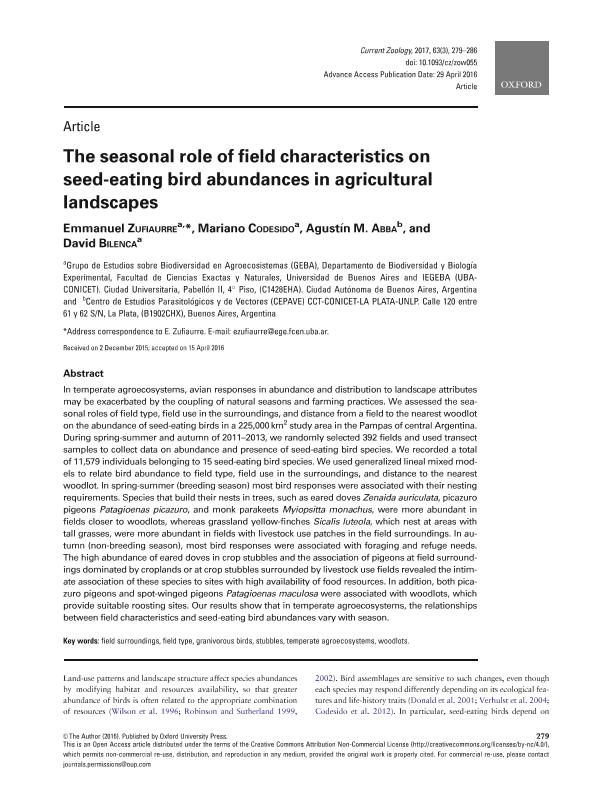Mostrar el registro sencillo del ítem
dc.contributor.author
Zufiaurre, Emmanuel

dc.contributor.author
Codesido, Mariano

dc.contributor.author
Abba, Agustin Manuel

dc.contributor.author
Bilenca, David Norberto

dc.date.available
2018-12-06T13:26:50Z
dc.date.issued
2017-06
dc.identifier.citation
Zufiaurre, Emmanuel; Codesido, Mariano; Abba, Agustin Manuel; Bilenca, David Norberto; The seasonal role of field characteristics on seed-eating bird abundances in agricultural landscapes; Oxford University Press; Current Zoology; 63; 3; 6-2017; 279-286
dc.identifier.issn
1674-5507
dc.identifier.uri
http://hdl.handle.net/11336/65961
dc.description.abstract
In temperate agroecosystems, avian responses in abundance and distribution to landscape attributes may be exacerbated by the coupling of natural seasons and farming practices. We assessed the seasonal roles of field type, field use in the surroundings, and distance from a field to the nearest woodlot on the abundance of seed-eating birds in a 225,000km2 study area in the Pampas of central Argentina. During spring-summer and autumn of 2011-2013, we randomly selected 392 fields and used transect samples to collect data on abundance and presence of seed-eating bird species. We recorded a total of 11,579 individuals belonging to 15 seed-eating bird species.We used generalized lineal mixed models to relate bird abundance to field type, field use in the surroundings, and distance to the nearest woodlot. In spring-summer (breeding season) most bird responses were associated with their nesting requirements. Species that build their nests in trees, such as eared doves Zenaida auriculata, picazuro pigeons Patagioenas picazuro, and monk parakeets Myiopsitta monachus, were more abundant in fields closer to woodlots, whereas grassland yellow-finches Sicalis luteola, which nest at areas with tall grasses, were more abundant in fields with livestock use patches in the field surroundings. In autumn (non-breeding season), most bird responses were associated with foraging and refuge needs. The high abundance of eared doves in crop stubbles and the association of pigeons at field surroundings dominated by croplands or at crop stubbles surrounded by livestock use fields revealed the intimate association of these species to sites with high availability of food resources. In addition, both picazuro pigeons and spot-winged pigeons Patagioenas maculosa were associated with woodlots, which provide suitable roosting sites. Our results show that in temperate agroecosystems, the relationships between field characteristics and seed-eating bird abundances vary with season.
dc.format
application/pdf
dc.language.iso
eng
dc.publisher
Oxford University Press
dc.rights
info:eu-repo/semantics/openAccess
dc.rights.uri
https://creativecommons.org/licenses/by-nc-sa/2.5/ar/
dc.subject
Field Surroundings
dc.subject
Field Type
dc.subject
Granivorous Birds
dc.subject
Stubbles
dc.subject
Temperate Agroecosystems
dc.subject
Woodlots
dc.subject.classification
Otras Ciencias Biológicas

dc.subject.classification
Ciencias Biológicas

dc.subject.classification
CIENCIAS NATURALES Y EXACTAS

dc.title
The seasonal role of field characteristics on seed-eating bird abundances in agricultural landscapes
dc.type
info:eu-repo/semantics/article
dc.type
info:ar-repo/semantics/artículo
dc.type
info:eu-repo/semantics/publishedVersion
dc.date.updated
2018-10-22T17:01:59Z
dc.journal.volume
63
dc.journal.number
3
dc.journal.pagination
279-286
dc.journal.pais
Reino Unido

dc.journal.ciudad
Oxford
dc.description.fil
Fil: Zufiaurre, Emmanuel. Consejo Nacional de Investigaciones Científicas y Técnicas. Oficina de Coordinación Administrativa Ciudad Universitaria. Instituto de Ecología, Genética y Evolución de Buenos Aires. Universidad de Buenos Aires. Facultad de Ciencias Exactas y Naturales. Instituto de Ecología, Genética y Evolución de Buenos Aires; Argentina
dc.description.fil
Fil: Codesido, Mariano. Consejo Nacional de Investigaciones Científicas y Técnicas. Oficina de Coordinación Administrativa Ciudad Universitaria. Instituto de Ecología, Genética y Evolución de Buenos Aires. Universidad de Buenos Aires. Facultad de Ciencias Exactas y Naturales. Instituto de Ecología, Genética y Evolución de Buenos Aires; Argentina
dc.description.fil
Fil: Abba, Agustin Manuel. Consejo Nacional de Investigaciones Científicas y Técnicas. Centro Científico Tecnológico Conicet - La Plata. Centro de Estudios Parasitológicos y de Vectores. Universidad Nacional de La Plata. Facultad de Ciencias Naturales y Museo. Centro de Estudios Parasitológicos y de Vectores; Argentina
dc.description.fil
Fil: Bilenca, David Norberto. Consejo Nacional de Investigaciones Científicas y Técnicas. Oficina de Coordinación Administrativa Ciudad Universitaria. Instituto de Ecología, Genética y Evolución de Buenos Aires. Universidad de Buenos Aires. Facultad de Ciencias Exactas y Naturales. Instituto de Ecología, Genética y Evolución de Buenos Aires; Argentina
dc.journal.title
Current Zoology
dc.relation.alternativeid
info:eu-repo/semantics/altIdentifier/doi/https://dx.doi.org/10.1093/cz/zow055
dc.relation.alternativeid
info:eu-repo/semantics/altIdentifier/url/https://academic.oup.com/cz/article/63/3/279/3057020
Archivos asociados
